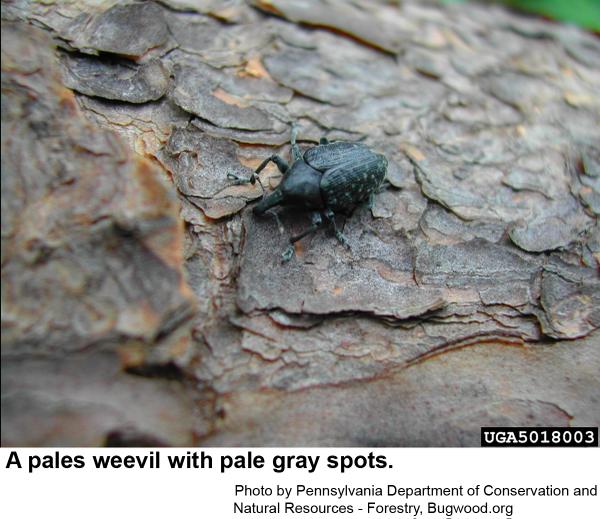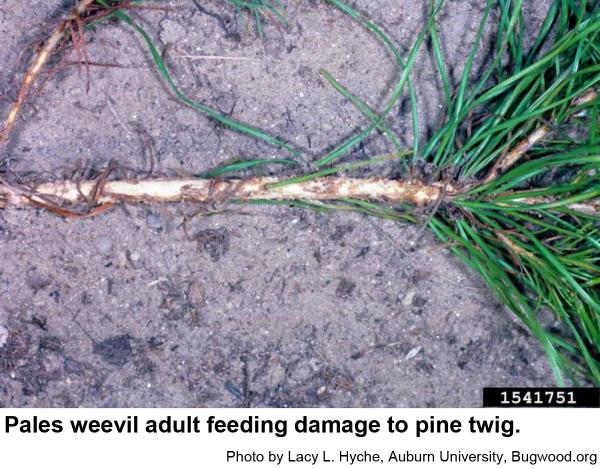Description and Biology
Pales weevils, Hylobius pales, overwinter as adults in the forest floor litter. (The common name is pronounced PAY-leez.) This is a very dark, elongate, oval insect up to 1/2 inch long with indistinct to distinct gray or pale orange spots of scales on the wings and thorax. Pales weevil grubs are typical legless weevil grubs with white bodies and brown heads. The adults are active in warm weather at night and hide during the day. In spring, the adults feed at night on the thin bark of conifer seedlings or near the tips of branches of larger plants before they fly to cut, damaged or recently dead pines to breed. After mating, females burrow underground to lay their eggs on the roots of these stumps and trees. They chew small niches and lay one to three eggs in each. New eggs are oval and white. Grubs tunnel downward in the roots as they mature. When mature, each grub fashions a cocoon of wood chips and pupates inside it. A new generation of weevils emerges in late summer or fall. Depending upon timing and altitude, we may have two generations of pales weevils per year in North Carolina.
Host Plants
Pales weevils breed in all species of pines, hemlocks, junipers, spruces, firs and cedars. It likely attacks any conifer growing near an area where pines or other conifers are harvested. The pales weevil is the most serious insect pest of pine reproduction in cutover pine land, and it readily invades landscapes. When pales weevils feed on bark, they eat it down to the wood and often girdle twigs that eventually flag and dieback. White, crystallized resin that resembles sugar forms over the wounds.
Residential Recommendations
Other than two parasitic fungi, little is known about biological control of pales weevils. Pyrethroid insecticides should protect conifers from weevil attack.When used as directed, pyrethroids are very toxic to insects but are not particularly hazardous to humans and pets (other than fish—avoid using pyrethroids around pools, ponds, and streams). These should be applied just as soon as the damage is first noticed. Pyrethroid insecticides labeled for landscape use are available in the plant sections of big box stores and nurseries.
Other Resources
- Pales Weevil. Day, E. and S. Salom. 2014. Virginia Polytechnic Institute and State University ENTO-103NP.
- Pales Weevil. Nord, J. C. et al. 1984 (revised). Forest Insect and Diseased Leaflet 104. 11 pp.
- Weevils. Hoffard, W. H. 2004 (update). Forest Pests: Insects, Diseases & Other Damage Agents.
- Extension Plant Pathology Publications and Factsheets
- Horticultural Science Publications
- North Carolina Agricultural Chemicals Manual
For assistance with a specific problem, contact your local N.C. Cooperative Extension center.
This Factsheet has not been peer reviewed.
Publication date: Feb. 18, 2019
Reviewed/Revised: Nov. 30, 2023
Recommendations for the use of agricultural chemicals are included in this publication as a convenience to the reader. The use of brand names and any mention or listing of commercial products or services in this publication does not imply endorsement by NC State University or N.C. A&T State University nor discrimination against similar products or services not mentioned. Individuals who use agricultural chemicals are responsible for ensuring that the intended use complies with current regulations and conforms to the product label. Be sure to obtain current information about usage regulations and examine a current product label before applying any chemical. For assistance, contact your local N.C. Cooperative Extension county center.
N.C. Cooperative Extension prohibits discrimination and harassment regardless of age, color, disability, family and marital status, gender identity, national origin, political beliefs, race, religion, sex (including pregnancy), sexual orientation and veteran status.







